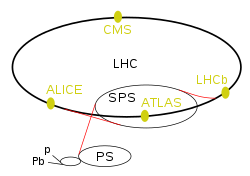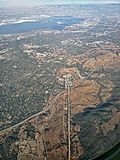The Large Electron–Positron Collider (LEP) was one of the largest particle accelerators ever constructed. It was built at CERN, a multi-national centre...
14 KB (1,767 words) - 15:10, 12 April 2025
The Circular Electron Positron Collider (CEPC) is a proposed Chinese electron positron collider for experimenting on the Higgs boson. It would be the world's...
5 KB (598 words) - 05:30, 29 January 2025
Electron–positron annihilation occurs when an electron (e− ) and a positron (e+ , the electron's antiparticle) collide. At low energies, the result of...
7 KB (825 words) - 18:13, 27 April 2025
the antiparticle (antimatter counterpart) of the electron. When a positron collides with an electron, annihilation occurs. If this collision occurs at...
35 KB (3,827 words) - 03:50, 17 February 2025
designs for proposed linear electron/positron colliders such as the International Linear Collider and the Compact Linear Collider. The study explores the...
84 KB (5,758 words) - 14:15, 1 April 2025
the LEP program. As its name implies, the Large Electron–Positron Collider collided electrons with positrons. The three most important ways in which such...
56 KB (6,324 words) - 10:27, 17 November 2024
The Beijing Electron–Positron Collider II (BEPC II) is a Chinese electron–positron collider, a type of particle accelerator, located in Shijingshan District...
5 KB (573 words) - 09:47, 7 April 2025
CERN (section Large Hadron Collider)
collider (the SppS collider), and for accelerating high energy electrons and positrons which were injected into the Large Electron–Positron Collider (LEP)...
119 KB (10,682 words) - 13:16, 10 April 2025
colliders Fixed-target experiment Large Electron–Positron Collider Large Hadron Collider Very Large Hadron Collider Relativistic Heavy Ion Collider International...
13 KB (1,343 words) - 02:59, 17 December 2024
ALEPH was a particle detector at the Large Electron-Positron collider (LEP) at CERN. It was designed to explore the physics predicted by the Standard Model...
5 KB (623 words) - 22:03, 7 September 2024
collision when compared to striking a static target with an electron. The Large Electron–Positron Collider (LEP) at CERN, which was operational from 1989 to 2000...
154 KB (15,743 words) - 00:06, 8 May 2025
Circular Electron Positron Collider Compact Linear Collider Future Circular Collider International Linear Collider Very Large Hadron Collider "The Large Hadron...
110 KB (10,982 words) - 14:56, 10 April 2025
SLAC National Accelerator Laboratory (redirect from Stanford Linear Collider)
collected by the SLAC Large Detector, which came online in 1991. Although largely overshadowed by the Large Electron–Positron Collider at CERN, which began...
30 KB (2,658 words) - 18:38, 15 May 2025
Supercollider (disambiguation) (redirect from Super Collider)
Large Hadron Collider The Very Large Hadron Collider, a hypothetical future hadron collider with no target date Tera-Large Electron–Positron Collider...
2 KB (275 words) - 23:37, 27 July 2022
LEP Pre-Injector (redirect from Electron Positron Accumulator)
initial source that provided electrons and positrons to CERN's accelerator complex for the Large Electron–Positron Collider (LEP) from 1989 until 2000....
10 KB (1,230 words) - 22:34, 6 July 2023
the experiments at the Large Electron–Positron Collider (ALEPH, DELPHI, L3 and OPAL). The first observation in a hadron collider was made by the scientists...
4 KB (402 words) - 22:47, 6 May 2025
Look up LEP in Wiktionary, the free dictionary. LEP is the Large Electron–Positron Collider, a particle accelerator. LEP or Lep may also refer to: Laser...
1 KB (184 words) - 21:34, 21 April 2024
VEPP in Russia, SLAC in the US, and the Large Electron–Positron Collider at CERN. Some of these lepton colliders are still running. Hadrons are compound...
36 KB (3,964 words) - 05:26, 6 May 2025
experiments at CERN's Large Electron–Positron Collider. OPAL studied particles and their interactions by collecting and analysing electron-positron collisions....
4 KB (442 words) - 11:49, 29 October 2024
pre-existing engineering infrastructure and 27 km long cavern of the Large Electron–Positron Collider, and its use of a different, innovative magnet design to bend...
35 KB (3,832 words) - 04:31, 13 April 2025
most energetic collider of heavy ions after it began colliding lead ions. Earlier facilities include the Large Electron–Positron Collider (LEP), which was...
42 KB (4,287 words) - 19:11, 29 April 2025
heavy particles—hadron colliders such as the LHC for protons or, alternatively, for lead nuclei. An electron–positron collider of the same size would...
22 KB (2,492 words) - 23:20, 24 October 2024
particle collider experiments, including B-physics, Higgs phenomenology and direct searches for superpartners (sparticles), at the Large Electron–Positron Collider...
68 KB (7,569 words) - 20:32, 18 April 2025
This is a list of experiments at CERN's Large Hadron Collider (LHC). The LHC is the most energetic particle collider in the world, and is used to test the...
13 KB (614 words) - 15:32, 8 April 2025
Identification) was one of the four main detectors of the Large Electron–Positron Collider (LEP) at CERN, one of the largest particle accelerators ever...
18 KB (2,030 words) - 22:57, 20 October 2024
CTF3 (redirect from CERN Linear Electron Accelerator for Research)
used to inject electrons and positrons into the CERN accelerator complex, to be ultimately delivered to Large Electron–Positron Collider (LEP). Following...
10 KB (1,059 words) - 11:31, 3 May 2025
ISABELLE (section Colliding beam accelerators)
first high energy hadron collider. The SPEAR collider at the Stanford Linear Accelerator Center, a 3+3 GeV electron-positron system, was completed in...
8 KB (880 words) - 16:42, 3 May 2022
List of accelerators in particle physics (redirect from List of particle colliders)
Undulator Radiation Collider: An Energy Efficient Design for a s = 15 GeV {\displaystyle {\sqrt {s}}=15~{\text{GeV}}} Collider". arXiv:1704.04469 [physics...
33 KB (657 words) - 09:47, 16 January 2025
Neutrino (section Collider neutrinos)
from the Large Electron–Positron Collider. In the 1960s, the now-famous Homestake experiment made the first measurement of the flux of electron neutrinos...
146 KB (14,435 words) - 16:49, 17 May 2025
and Hadron Identification), one of the four detectors of the Large Electron-Positron Collider at CERN Delphi method, a forecasting technique which relies...
2 KB (277 words) - 12:28, 13 May 2025
















